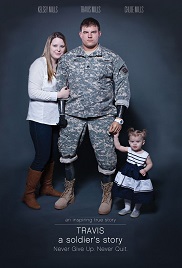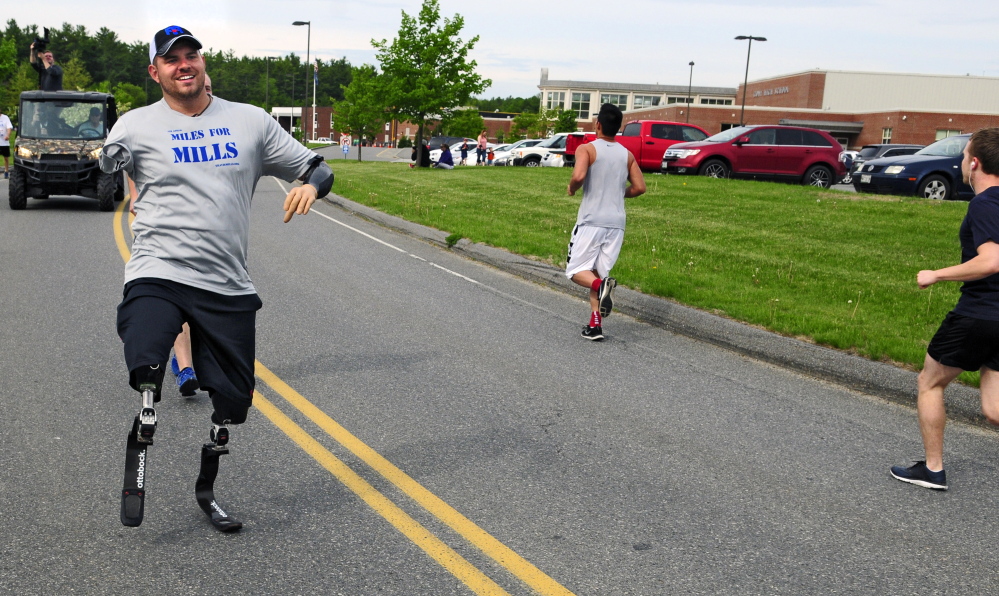One of the Best! This movie is on TWM’s list of the ten best movies to supplement classes in Health, High School Level.
Click here for TWM’s movie worksheet for this film. Teachers can modify the worksheet to fit the needs of their classes.
This is the story of Army Sergeant Travis Mills. In 2012, Sergeant Mills lost four limbs to an IED while serving in Afghanistan. The film describes his early life, his service while in the army, the injury, and his rehabilitation. It is a story of grit and resilience in the face of devastating loss.
Selected Awards:
Best documentary short at the GI Film Festival;
Featured Actors:
Travis Mills, Kelsey Mills, Chloe Mills, Steve Mokate, Ryan Theriot, Josh Buck, Daniel Bateson, and Brandon Fessey.
Director:
Jonathon Link.
Learning about Travis Mills’ service as a soldier, the amazing medical care provided by the Army, the strong support from his family, his resilience, and his continuing triumph over adversity is beneficial to any one at any age, and especially to adolescents.
Students will learn the value of resilience, of strong families, the importance of institutions that work for the benefit of their constituents, and that incredible tragedy can be overcome. Students will be motivated to exercise their writing and speaking skills in response to assignments relating to Sergeant Mills’ story. Students may become interested in reading Sergeant Mills’ best selling book, Tough As They Come.
There are a number of images of the bloody stumps of severed limbs.
Watch the movie with your child and discuss the different resources drawn on by Sergeant Mills to cope with his injuries (including helping others, accepting the love of family and friends, and developing a project such as writing his book and building his motivational speaking business).
The film needs no introduction. It is apparently factually correct.
After watching the movie give the class the following direct instruction:
There are four other quadruple amputees among U.S. veterans. Each of their stories will have a unique set of circumstances. There are also approximately 40 triple amputees. There are a total of 1,500 amputee veterans from the Afghanistan and Iraq wars.
In addition, there are several civilians who have had all of their limbs amputated for one reason or another. [Share your favorite story with the class. We suggest the story of Karen Crespo, a young woman who lost all of her limbs to an infection and then became the first quadruple amputee to walk the runway at New York Fashion Week. See Quadruple Amputee Hits New York Fashion Week Runway, Rediscovers Self-Confidence by Alena Hall Huffington Post 9/8/14.]
Resilience can be defined as the capacity to recover from difficulties. In a word, “toughness.” [Give the class an example of resilience. One of our favorites is Ludwig van Beethoven, the great classical composer. He began going deaf at the age of 31, before most of his great musical masterworks had been written. He contemplated suicide but decided to live for and through his art. Beethoven lived another 16 years and continued to compose music even though he became profoundly deaf and could hear nothing. The bulk of his work, including the Sonatas for Piano and the great symphonies of The Heroica, the Fifth Symphony, The Pastoral, and the Ninth Symphony were all written in the face in his increasing deafness.]
Resilience is something people exhibit every day in things large and small. It includes recovering from a poor grade on a test to get a better grade in the class, coming back from a breakup of a romance, or just having a bad morning and deciding that it’s not going to spoil the rest of your day.
One of the major things to take away from this film is the excellent medical care provided by the U.S. Army to Sergeant Mills. It’s reassuring to hear that an important institution in American society works so well.
After watching the film, engage the class in the following discussion.
1. Share a story of resilience with the class. It can be about something important or minor.
2. If you were to suffer a catastrophic physical injury or other loss, describe some steps you could take to cope with your new situation.
Suggested Responses:
-
- Accept the loss as something real and something grievous; denial is not a good way to deal with loss.
- Give yourself space and time to experience your feelings.
- Give yourself permission to cry, even if you are male.
- Accept and seek support from family, friends, support groups, and therapists.
- Experience nature: it can be incredibly healing.
- Involve yourself in a project that absorbs your time, attention, and energy.
- Express your feelings in some artistic endeavor that you can still perform: such as poetry, drawing, or music.
- Take care of yourself physically; get enough sleep; eat a healthy diet; get outside into the sunshine; hard physical exercise releases chemicals in your brain that moderate emotions.
- When the first rush of grief is gone, plan ahead for dealing with situations that will trigger your grief.
3. If you were to suffer a catastrophic physical injury, describe some things that you should not do.
Suggested Responses:
a. Try to suppress your feelings and soldier on in life as if you have not been injured; on the contrary, acknowledge the legitimacy of the way you feel.
b. Allow others to tell you how you should be feeling.
c. Use alcohol or drugs to numb the pain.
d. Make major decisions before you have your emotions under control; grieving the loss of important parts of your body is a time of instability.
COURAGE IN WAR
See general discussion questions 1 — 3.
1. What elements of courage did Sergeant Mills display?
Suggested Response:
He was careful but fearless on the battlefield. He was courageous in facing up to his injuries.
SURVIVING (Resilience)
See general discussion questions 1 — 3.
RESPONSIBILITY
(Do what you are supposed to do; Persevere: keep on trying!; Always do your best; Use self-control; Be self-disciplined; Think before you act — consider the consequences; Be accountable for your choices)
2. Look at the Character Counts Pillar of “Responsibility.” Did this apply to Sergeant Mills despite his injury? Explain your answer. Then describe how Sergeant Mills honored this ethical principal after his injury.
Suggested Response:
No matter how injured we may be, we are still human beings, and we still have an obligation to act ethically. Sergeant Mills, for example, was a father. He has a big role to play in the life of his daughter. He is also a husband and son; again, he has responsibilities to his wife and parents. Sergeant Mills fulfilled that role by coming back from his injury, persevering, doing his best, using self-control, and self-discipline to become as functional a human being as possible.
3. What if Sergeant Mills did not have all of the prosthetic devices that modern medicine was able to provide for him? How would this affect his obligation to act in a responsible fashion?
Suggested Response:
He would still be subject to the obligations of the ethical principle, but only to the extent that he was able to take action.
Any of the discussion questions and Questions 1 – 5 of the Film-Study Worksheet can serve as a writing prompt. Another assignment is to ask students to research and write an essay relating to one of the following topics:
a. The history of the U.S. Army’s efforts to provide immediate care for battlefield injuries;
b. The current system used by the U.S. Army to provide emergency medical care for wounded soldiers; or
c. The life story of any quadruple amputee or a triple amputee, civilian or military, focusing on the concept of resilience and how they coped with their injuries.
Multimedia:
Anchor Standard #7 for Reading (for both ELA classes and for History/Social Studies, Science, and Technical Classes). (The three Anchor Standards read: “Integrate and evaluate content presented in diverse media, including visually and quantitatively as well as in words.”) CCSS pp. 35 & 60. See also Anchor Standard # 2 for ELA Speaking and Listening, CCSS pg. 48.
Reading:
Anchor Standards #s 1, 2, 7, and 8 for Reading and related standards (for both ELA classes and for History/Social Studies, Science, and Technical Classes). CCSS pp. 35 & 60.
Writing:
Anchor Standards #s 1 – 5 and 7- 10 for Writing and related standards (for both ELA classes and for History/Social Studies, Science, and Technical Classes). CCSS pp. 41 & 63.
Speaking and Listening:
Anchor Standards #s 1 – 3 (for ELA classes). CCSS pg. 48.
Not all assignments reach all Anchor Standards. Teachers are encouraged to review the specific standards to make sure that over the term all standards are met.
Students interested in this film may want to read Sergeant Mills’ best selling book, Tough As They Come.
Non-Military Quadruple Amputees
In addition to websites which may be linked in the Guide and selected film reviews listed on the Movie Review Query Engine, the following resources were consulted in the preparation of this Learning Guide:
Tough As They Come, by SSG Travis Mills with Marcus Brotherton, Convergent Books, 2015.
This Learning Guide was written by James Frieden and was published on July 18, 2016.






